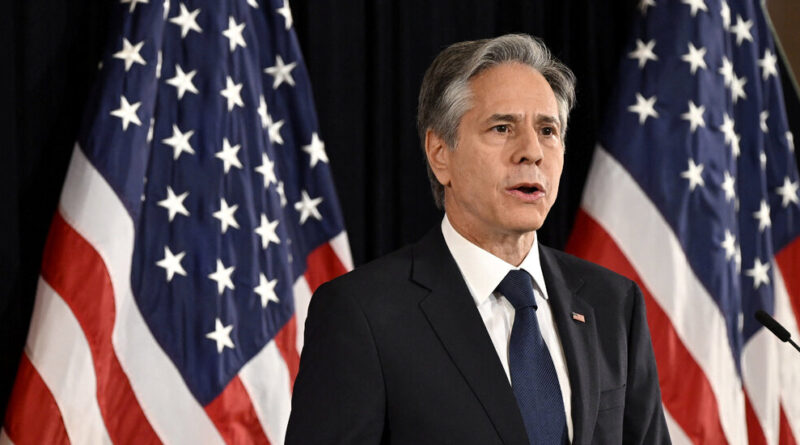In Finland, NATO’s Newest Member, Blinken Details Russia’s ‘Failures’
[ad_1]
Secretary of State Antony J. Blinken on Friday took the stage in NATO’s newest member, Finland, to say that further strengthening Ukraine’s defenses against Russia was a “prerequisite” for diplomacy to end the war in Ukraine and to warn against short-term cease-fires that might play to Moscow’s advantage.
In a powerfully symbolic address at the City Hall in Helsinki, Finland’s capital, Mr. Blinken cataloged the many ways the war by President Vladimir V. Putin of Russia had backfired since Moscow launched a full-scale invasion of Ukraine in February 2022.
He noted, for one, Finland’s decision last year to break from decades of firm neutrality and join the NATO alliance in a major strategic blow to Mr. Putin, who calls NATO’s expansion a grave threat to Russian security.
Mr. Putin’s war “has been a strategic failure — greatly diminishing Russia’s power, its interests and its influence for years to come,” Mr. Blinken said. “When you look at President Putin’s long-term strategic aims and objectives, there is no question: Russia is significantly worse off today than it was before the full-scale invasion — militarily, economically, geopolitically,” he added.
“Where Putin aimed to project strength, he has revealed weakness,” he said. “Where he sought to divide, he has united. What he tried to prevent, he has precipitated.”
Although Mr. Blinken’s speech broke little new ground, its delivery from a country that shares an 832-mile border with Russia, and that the NATO alliance is now committed to defending, amounted to a victory lap likely to embarrass if not infuriate Mr. Putin.
Finland’s official entry into NATO in April, Mr. Blinken said, was “a sea change that would have been unthinkable” before the war in Ukraine — and one that Mr. Putin had brought upon himself by invading his neighbor.
Mr. Blinken spoke at the end of a weeklong trip to Norway, Sweden and Finland that included meetings with NATO officials meant to highlight Western resolve against Russia and discuss the alliance’s long-term relationship with Ukraine, which is seeking NATO membership and security guarantees.
Speaking to European leaders on Thursday, President Volodymyr Zelensky of Ukraine argued for his country’s membership in NATO, saying “a clear invitation from members of Ukraine is needed” this year. But in remarks on Friday he also acknowledged that Ukraine could not join the alliance so long as it was at war with Russia.
Both the president of France and Britain’s defense minister have made a similar point in recent days, saying they support Ukraine but that full NATO membership was for the moment out of reach.
Mr. Putin has cited NATO’s eastward expansion as one of his justifications for the invasion. On Friday, a Kremlin spokesman, Dmitry S. Peskov, said that Russia would continue to act in its national security interests, according to the state news agency Tass.
“This means preventing alliance’s expansion, as well as its obvious advance toward our borders and Ukraine’s possible NATO membership,” he said.
In his 40-minute address on Friday, Mr. Blinken made a case for the Biden administration’s thinking about the war, saying that Mr. Putin had unwittingly exposed and compounded the weakness of Russia’s military, hobbled its economy, cost it energy revenue, and inspired NATO to become better-funded, more united — and larger.
The speech had a sometimes triumphal tone: At one point, Mr. Blinken joked that Russia’s military, once billed as the second strongest in the world, was now “the second strongest in Ukraine.” But it also included cautionary notes about the long and difficult road ahead for Ukraine, particularly amid what Mr. Blinken predicted would be new calls for a halt to the fighting.
U.S. officials believe that if, as expected, a coming Ukrainian counteroffensive fails to make dramatic gains, pressure will grow from around the world to find a way to at least pause the fighting.
“Over the coming months, some countries will call for a cease-fire,” Mr. Blinken said. “On the surface, that sounds sensible — attractive, even. After all, who doesn’t want warring parties to lay down their arms? Who doesn’t want the killing to stop?”
But a cease-fire that freezes current lines in place, with Russia controlling large areas of Ukrainian territory, he added, “is not a just and lasting peace. It is a Potemkin peace. It would legitimize Russia’s land grab. It would reward the aggressor and punish the victim.”
While insisting that the United States and Ukraine would like to see an end to the war, Mr. Blinken warned that Mr. Putin does not seem ready for good-faith negotiations. The Russian leader has insisted that talks can only occur once Ukraine accepts Russia’s claims to have annexed four of its eastern regions.
Samuel Charap, a former State Department official in the Obama administration and a Russia analyst with the RAND Corporation, said that Mr. Blinken may be setting too high a standard.
“If seriousness about talks means willingness to make pre-emptive concessions on territory, Putin will never meet that bar,” Mr. Charap said.
Many U.S. officials believe that Mr. Putin aspires to gain far greater control of Ukraine than he has now, something that will require him to play for time.
The Russian leader is “convinced he can simply outlast Ukraine and its supporters — sending more and more Russians to their deaths, and inflicting more and more suffering on Ukrainian civilians,” Mr. Blinken said. “He thinks even if he loses the short game, he can still win the long game.”
Still, Mr. Blinken added, the United States would support any peace initiative “that helps bring President Putin to the table to engage in meaningful diplomacy,” the secretary of state said. He added that such efforts must include Russian accountability for wartime atrocities and payments for Ukraine’s reconstruction.
Mr. Blinken said, as he has before, that a peace deal would have to “affirm the principles of sovereignty, territorial integrity and independence.” But, also as before, he did not specify whether the U.S. believes that Russia must withdraw from all Ukrainian territory — including the strategic Crimean Peninsula, which Russia annexed in 2014 and which many analysts believe Mr. Putin will never surrender.
Mr. Blinken also said that a genuine peace deal could open the door to the lifting of Western sanctions on Russia “connected to concrete actions, especially military withdrawal.” And he reiterated that “the U.S. does not seek to overthrow the Russian government.”
Earlier on Friday, Mr. Blinken met with Finland’s departing prime minister, Sanna Marin, and the country’s foreign minister, Pekka Haavisto.
Mr. Blinken marveled at Finland’s accession into NATO, suggesting that it amounted to a colossal blunder by Mr. Putin, who previously had relatively friendly relations with Helsinki. Before Russia’s invasion of Ukraine, he noted, just one in four Finns supported the country’s joining NATO. After the invasion, three in four Finns supported NATO membership, he said.
Mr. Blinken’s appearance in Helsinki was all the more striking when compared to the last time a visit here by a major U.S. official made headlines. Five years ago, President Donald J. Trump traveled to the Finnish capital for a meeting with Mr. Putin — a trip infamous for Mr. Trump’s suggestion, at a news conference alongside the Russian leader, that he trusted Mr. Putin’s denial of interfering in the 2016 election over the conclusions of U.S. intelligence agencies.
Earlier in the week, Mr. Blinken visited Sweden, whose bid to join the Atlantic alliance has been held up by Turkey, and on Thursday met with allied foreign ministers in Oslo to discuss concerns about Ukraine’s long-term security.
Helsinki was expected to be Mr. Blinken’s last stop on a Nordic tour as Russia, China and the NATO nations jockey for stronger positions in the Arctic. Later this year, the United States will open a mission staffed by a single diplomat in the town of Tromso, Norway — its only such facility above the Arctic Circle — Mr. Blinken said at a news conference on Thursday.
[ad_2]
Source link



